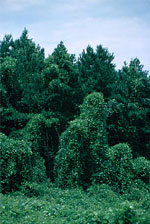Threats to Birds -
Kudzu (Pueraria montana var. lobata)
Overview
This vine was displayed by the Japanese at the Philadelphia Centennial Exposition in 1876. In the 1930s and 1940s, the kudzu was promoted by the Soil Conservation Service as a means of holding soil on deforested areas in the south. The U.S. federal government paid farmers to grow it and more than 1.2 million acres were planted through that program. It was also grown as an ornamental and forage crop. Kudzu can engulf trees and forests of 10 or more acres, and can grow as much as one foot per day. This fast-growing vine now blankets large areas of the Southeast, but it has also been seen as far north as Massachusetts and west to Texas.
Description
A perennial, semi-woody green vine with broad green leaves and a twining and trailing growth habit that can form dense infestation covering ground and trees. Leaves are alternate, 3-leaflet, usually slightly lobed. Flowers in reddish-purple spike-like racemes. Fruit is a flattened legume, hairy, which splits to release several oval and hard-coated seeds.
Birds Affected
Forest-dwelling birds
Control
Mowing and herbicides can help stop an invasion. Also bio-control in the form of insects such as army worms. Repeated herbicide treatments and overgrazing have been the most successful control treatment followed by pine and pasture grass planting. |
